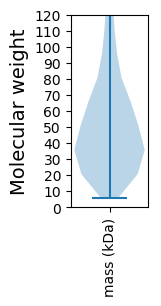
Venustampulla echinocandica
Taxonomy: cellular organisms; Eukaryota; Opisthokonta; Fungi; Dikarya; Ascomycota; saccharomyceta; Pezizomycotina; leotiomyceta; sordariomyceta; Leotiomycetes; Helotiales; Pleuroascaceae; Venustampulla
Average proteome isoelectric point is 6.48
Get precalculated fractions of proteins

Virtual 2D-PAGE plot for 10697 proteins (isoelectric point calculated using IPC2_protein)
Get csv file with sequences according to given criteria:
* You can choose from 21 different methods for calculating isoelectric point
Summary statistics related to proteome-wise predictions



Protein with the lowest isoelectric point:
>tr|A0A370TXZ0|A0A370TXZ0_9HELO Uncharacterized protein OS=Venustampulla echinocandica OX=2656787 GN=BP5553_00357 PE=4 SV=1
MM1 pKa = 7.81AEE3 pKa = 4.2NIYY6 pKa = 11.01DD7 pKa = 4.05EE8 pKa = 5.38IEE10 pKa = 4.56IEE12 pKa = 4.86DD13 pKa = 3.87MTYY16 pKa = 10.95DD17 pKa = 3.48AAIGIYY23 pKa = 9.7HH24 pKa = 6.0YY25 pKa = 9.67PCPCGDD31 pKa = 3.63RR32 pKa = 11.84FQIALADD39 pKa = 3.86LRR41 pKa = 11.84DD42 pKa = 3.79EE43 pKa = 4.51EE44 pKa = 6.24DD45 pKa = 3.22IAVCPSCSLMIRR57 pKa = 11.84VIFEE61 pKa = 3.84VDD63 pKa = 4.26DD64 pKa = 4.08LPKK67 pKa = 10.54PADD70 pKa = 3.75EE71 pKa = 4.32EE72 pKa = 4.34AKK74 pKa = 10.63EE75 pKa = 3.82PAAAVAVAAA84 pKa = 4.86
MM1 pKa = 7.81AEE3 pKa = 4.2NIYY6 pKa = 11.01DD7 pKa = 4.05EE8 pKa = 5.38IEE10 pKa = 4.56IEE12 pKa = 4.86DD13 pKa = 3.87MTYY16 pKa = 10.95DD17 pKa = 3.48AAIGIYY23 pKa = 9.7HH24 pKa = 6.0YY25 pKa = 9.67PCPCGDD31 pKa = 3.63RR32 pKa = 11.84FQIALADD39 pKa = 3.86LRR41 pKa = 11.84DD42 pKa = 3.79EE43 pKa = 4.51EE44 pKa = 6.24DD45 pKa = 3.22IAVCPSCSLMIRR57 pKa = 11.84VIFEE61 pKa = 3.84VDD63 pKa = 4.26DD64 pKa = 4.08LPKK67 pKa = 10.54PADD70 pKa = 3.75EE71 pKa = 4.32EE72 pKa = 4.34AKK74 pKa = 10.63EE75 pKa = 3.82PAAAVAVAAA84 pKa = 4.86
Molecular weight: 9.25 kDa
Isoelectric point according different methods:
Protein with the highest isoelectric point:
>tr|A0A370TUT5|A0A370TUT5_9HELO HET domain-containing protein OS=Venustampulla echinocandica OX=2656787 GN=BP5553_03637 PE=4 SV=1
MM1 pKa = 7.39GAGRR5 pKa = 11.84SPPVVRR11 pKa = 11.84KK12 pKa = 9.8VKK14 pKa = 10.38LRR16 pKa = 11.84LPHH19 pKa = 6.46FPQSVGGNGALASNGGQNSMGHH41 pKa = 6.15NPTPTPPAPTVGNRR55 pKa = 11.84GGGGGGRR62 pKa = 11.84GSMMGQNRR70 pKa = 11.84LAMGNGPNGVGSGNVMGRR88 pKa = 11.84NGVNGPPTGNPDD100 pKa = 3.27GGGSGMGSFGPPMRR114 pKa = 11.84IPSRR118 pKa = 11.84GGRR121 pKa = 11.84GGSRR125 pKa = 11.84GGSRR129 pKa = 11.84GGGRR133 pKa = 11.84GGGILARR140 pKa = 11.84GGGSRR145 pKa = 11.84RR146 pKa = 11.84VV147 pKa = 3.19
MM1 pKa = 7.39GAGRR5 pKa = 11.84SPPVVRR11 pKa = 11.84KK12 pKa = 9.8VKK14 pKa = 10.38LRR16 pKa = 11.84LPHH19 pKa = 6.46FPQSVGGNGALASNGGQNSMGHH41 pKa = 6.15NPTPTPPAPTVGNRR55 pKa = 11.84GGGGGGRR62 pKa = 11.84GSMMGQNRR70 pKa = 11.84LAMGNGPNGVGSGNVMGRR88 pKa = 11.84NGVNGPPTGNPDD100 pKa = 3.27GGGSGMGSFGPPMRR114 pKa = 11.84IPSRR118 pKa = 11.84GGRR121 pKa = 11.84GGSRR125 pKa = 11.84GGSRR129 pKa = 11.84GGGRR133 pKa = 11.84GGGILARR140 pKa = 11.84GGGSRR145 pKa = 11.84RR146 pKa = 11.84VV147 pKa = 3.19
Molecular weight: 14.06 kDa
Isoelectric point according different methods:
Peptides (in silico digests for buttom-up proteomics)
Below you can find in silico digests of the whole proteome with Trypsin, Chymotrypsin, Trypsin+LysC, LysN, ArgC proteases suitable for different mass spec machines.| Try ESI |
 |
|---|
| ChTry ESI |
 |
|---|
| ArgC ESI |
 |
|---|
| LysN ESI |
 |
|---|
| TryLysC ESI |
 |
|---|
| Try MALDI |
 |
|---|
| ChTry MALDI |
 |
|---|
| ArgC MALDI |
 |
|---|
| LysN MALDI |
 |
|---|
| TryLysC MALDI |
 |
|---|
| Try LTQ |
 |
|---|
| ChTry LTQ |
 |
|---|
| ArgC LTQ |
 |
|---|
| LysN LTQ |
 |
|---|
| TryLysC LTQ |
 |
|---|
| Try MSlow |
 |
|---|
| ChTry MSlow |
 |
|---|
| ArgC MSlow |
 |
|---|
| LysN MSlow |
 |
|---|
| TryLysC MSlow |
 |
|---|
| Try MShigh |
 |
|---|
| ChTry MShigh |
 |
|---|
| ArgC MShigh |
 |
|---|
| LysN MShigh |
 |
|---|
| TryLysC MShigh |
 |
|---|
General Statistics
Number of major isoforms |
Number of additional isoforms |
Number of all proteins |
Number of amino acids |
Min. Seq. Length |
Max. Seq. Length |
Avg. Seq. Length |
Avg. Mol. Weight |
|---|---|---|---|---|---|---|---|
0 |
5497940 |
52 |
13565 |
514.0 |
56.79 |
Amino acid frequency
Ala |
Cys |
Asp |
Glu |
Phe |
Gly |
His |
Ile |
Lys |
Leu |
|---|---|---|---|---|---|---|---|---|---|
8.4 ± 0.018 | 1.212 ± 0.009 |
5.615 ± 0.015 | 6.189 ± 0.023 |
3.663 ± 0.014 | 6.985 ± 0.023 |
2.303 ± 0.009 | 5.186 ± 0.016 |
5.075 ± 0.023 | 8.834 ± 0.026 |
Met |
Asn |
Gln |
Pro |
Arg |
Ser |
Thr |
Val |
Trp |
Tyr |
|---|---|---|---|---|---|---|---|---|---|
2.171 ± 0.008 | 3.845 ± 0.012 |
6.145 ± 0.026 | 3.969 ± 0.017 |
5.878 ± 0.021 | 8.423 ± 0.027 |
5.999 ± 0.017 | 5.959 ± 0.019 |
1.414 ± 0.009 | 2.735 ± 0.011 |
Most of the basic statistics you can see at this page can be downloaded from this CSV file
Proteome-pI is available under Creative Commons Attribution-NoDerivs license, for more details see here
| Reference: Kozlowski LP. Proteome-pI 2.0: Proteome Isoelectric Point Database Update. Nucleic Acids Res. 2021, doi: 10.1093/nar/gkab944 | Contact: Lukasz P. Kozlowski |
